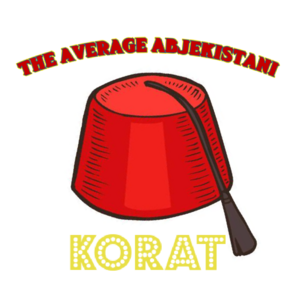Abjekistan: Difference between revisions
(→Medias) |
(→Medias) |
||
| Line 160: | Line 160: | ||
==Medias== | ==Medias== | ||
[[File:Korat, the average Abjekistani.png|thumb|right|Thumbnail of the 24th season of Korat]] | [[File:Korat, the average Abjekistani.png|thumb|right|Thumbnail of the 24th season of Korat]] | ||
The region of Koshanda | The region of Koshanda is recognized for its soap operas, musicals and humoristic programs. The most popular is certainly Korat, the average Abjekistani. Korat was a weekly humoristic television show produced from 1959 to 1992 recounting the hectic life of Korat Belmuth, a citizen of the small city of Sirmak, located in the eastern Cheburek plains. A movie called ''Korat in Encessia'' was released in early 2021, and rumors of a sequel have come to our ears recently... | ||
=Industry= | =Industry= | ||
==Automotive== | ==Automotive== | ||
Revision as of 14:55, 13 April 2021
People's Republic of Abjekistan A'bjegistan Halk Respublikasy | |
|---|---|
| Motto: Abjekistan, gaty gowy ýer! ("Abjekistan, you very nice place!") | |
| Anthem: Abjekh adamlar! ("Together, Abjekh people") | |
| Capital | Noruzabad |
| Official languages | |
| Ethnic groups |
|
| Religion |
|
| Demonym(s) | Abjekistanian |
| Government | Socialist Democracy |
• National Representative | Borankh Abdulaziz Olimov |
• Regional Representatives | 6 Delegates |
• District Representatives | 36 Delegates |
• Municipality Representatives | approx. 150 Delegates |
• Electors | The population |
| Independent state | |
• First Democratic elections | December 21th 1967 |
• Independence from Krenya | May 10th 1936 |
• Insurgencies against the Krenyan royalty | 1934-1936 |
• Abjekistan is declared Krenyan colony | 1765 |
• Abjekh-Krenyan war | 1757-1765 |
| Population | |
• January 2020 estimate | 10,722,000 |
| GDP (PPP) | 2020 estimate |
• Total | ~$357 billion |
| HDI (2019) | high |
| Currency | Puzhaks (ABP) |
| Driving side | right |
| Calling code | +151 |
| Internet TLD | .Ab |
Abjekistan, officially the People's Republic of Abjekistan ( Abjekh: A'bjegistan) is a Sovereign State in Central Thrismari. It is landlocked and is bordering Mehrava to the south-west, Encessia and Jehovikra to the South-East and The Great Golden Raj to the North. The South of the country, mostly the regions of Yădakstan and Günorta are known for being one of the cradles of civilization, with recent archaeological excavations dating the city of Aksaz to more than 20,000 years. The country actually contains 6 great nations, very different from each other, but who share the same language and some similar traditions.
Etymology
TBA
History
Abjekh Nomadic Tribes
TBA
The Three Kingdoms
TBA
Abjekh Empire
Its history dates back to the unification of the nomadic peoples of the north and center of the country by the Yădakk empire, which had developed enormously with its immense road network linking the desolate plateau of Khalee to the Margiric Gulf. The empire, which unified all tribes of Abjekh origin, came to be called the Abjekh Empire.
Krenian conquest
TBA
The City-State of Krenşäheri
Notice: this section is heavily Work-in-Progress, meaning that it is prone to important changes
The City-State of Krenşäheri is a micronation within Abjekistan, located on the coast of the Khizuz sea, in Günorta. It is not recognized as a sovereign state but more of a semi-autonomous state mostly controlled by Abjekistan. To enter the city, you need to have a valid passeport. Their currency is the Krenen.
Politics
Government (WIP)
There are no political parties in Abjekistan. Abjekistanians vote for their District Representants (There are 6 districts by region), who then elect a Regional Representant. The RRs then elect ministry members, supreme court members, etc. The power is thus divided between the people, the District Representants and the Regional Representants.
Administrative regions
| Regional Flag | Name | Largest Ciy |
|---|---|---|
 |
Yădakstan | Koshanda |
 |
Materikia | Yerden |
 |
Düýestan | Sirmak |
 |
Günorta | Noruzabad (Khinalykh) |
 |
Kamelýa | Tarnov |
 |
Cheburekia | Korobankh |
| Kaşmir islands | Nafak |
List of Ministries
- Ministry of Foreign Relations (AMFR)
- Ministry of Culture and Medias (AMCM)
- Ministry of the Automotive Industry (AMAI)
- Ministry of the Finance and Economy (AMFE)
- Ministry of Healthcare and Welfare (AMHW)
- Ministry of Defense (A-MD)
- Ministry of Education (A-ME)
- Ministry of the Transports (A-MT)
- Ministry of Justice (A-MT)
- Ministry of the National Militia (AMNM)
- Abjekistan Investigation Bureau (AIB)
Foreign Relations
Krenya
WIP
Foxomexra
WIP
Encessia
WIP
Mehrava
WIP
Culture
Music[1]
Abjekhs love active and entertaining music, such as Bouzoukis, Kasatchoks and and traditional Yadakk music. The most popular dances are group dances, like the Koshandan line dance [2], which originates from the massive Thuadian immigration wave in the 1880s, and the Abjekh kick dance.
Fashion
The traditional Abjekh clothing may vary according to the regions, but the Abjekh outfit constitutes of a burgundy fez, a White Tchekeska, colored baggy pants and high boots for men. Women often wear the Perankh, a colorful dress decorated with golden flowers.
Medias
The region of Koshanda is recognized for its soap operas, musicals and humoristic programs. The most popular is certainly Korat, the average Abjekistani. Korat was a weekly humoristic television show produced from 1959 to 1992 recounting the hectic life of Korat Belmuth, a citizen of the small city of Sirmak, located in the eastern Cheburek plains. A movie called Korat in Encessia was released in early 2021, and rumors of a sequel have come to our ears recently...


